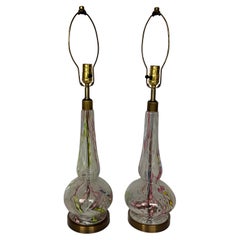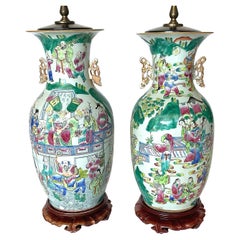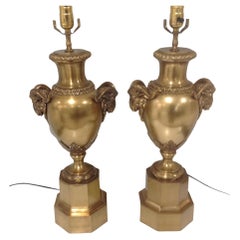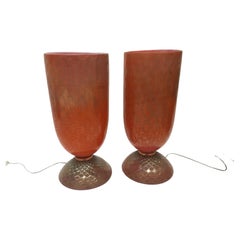Want more images or videos?
Request additional images or videos from the seller
1 of 8
Rivière Studios Grapevine Pattern Early Art Nouveau Panel Lamp
$5,200List Price
About the Item
- Creator:Riviere Studios (Maker)
- Dimensions:Height: 21 in (53.34 cm)Width: 8.5 in (21.59 cm)Depth: 8.5 in (21.59 cm)
- Power Source:Plug-in
- Lampshade:Included
- Style:Art Nouveau (Of the Period)
- Materials and Techniques:
- Place of Origin:
- Period:
- Date of Manufacture:1920s
- Condition:Wear consistent with age and use.
- Seller Location:Ann Arbor, MI
- Reference Number:1stDibs: LU6641234133592
About the Seller
5.0
Vetted Professional Seller
Every seller passes strict standards for authenticity and reliability
Established in 1990
1stDibs seller since 2022
48 sales on 1stDibs
Typical response time: 1 hour
Authenticity Guarantee
In the unlikely event there’s an issue with an item’s authenticity, contact us within 1 year for a full refund. DetailsMoney-Back Guarantee
If your item is not as described, is damaged in transit, or does not arrive, contact us within 7 days for a full refund. Details24-Hour Cancellation
You have a 24-hour grace period in which to reconsider your purchase, with no questions asked.Vetted Professional Sellers
Our world-class sellers must adhere to strict standards for service and quality, maintaining the integrity of our listings.Price-Match Guarantee
If you find that a seller listed the same item for a lower price elsewhere, we’ll match it.Trusted Global Delivery
Our best-in-class carrier network provides specialized shipping options worldwide, including custom delivery.You May Also Like
Riviere Studios Lamp
By Riviere Studios
Located in Pompano Beach, FL
Riviere Studios glass and bronze grapevine lamp. Brown/green patina, base and shade.
Category
Early 20th Century American Table Lamps
Materials
Bronze
Antique Early Riviere Grapevine Desk/Table Lamp - Stickley era W5666 SALE
Located in Shamokin Dam, PA
Antique Early Riviere Grapevine Desk/Table Lamp
This is an Antique Early Riviere Grapevine Desk/Table Lamp from the early 1900s in very good condition. The lamp shade is vintage but...
Category
Early 20th Century American Arts and Crafts Table Lamps
Materials
Bronze
$1,440 Sale Price
20% Off
H 11 in Dm 5.25 in
Art Nouveau Italian Carved Alabaster Marble Small Urn & Grapevine Table Lamp
Located in Philadelphia, PA
Antique Art Nouveau Italian Carved Alabaster Marble Small Urn & Grapevine Table Lamp. Circa Early 20th Century. Measurements: 23" H (to finial) x 15" H (to light socket) x 5.5" W x 4...
Category
Early 20th Century Unknown Art Nouveau Table Lamps
Materials
Marble
$350
H 23 in W 5.5 in D 4 in
Tiffany Studios Style Art Nouveau Bronze Counterbalance Desk Lamp
By Tiffany Studios
Located in South Bend, IN
A gorgeous Art Nouveau or Arts & Crafts desk lamp or table lamp
In the manner of Tiffany Studios
USA, Circa Mid-20th Century
Bronze base, with gorgeous Louis Comfort Tiffany style...
Category
Mid-20th Century American Art Nouveau Table Lamps
Materials
Bronze
Hand-Painted Metal Grapevine Table Lamp in Hollywood Regency / Art Nouveau Style
Located in Antwerp, BE
Hand-Painted Metal Grapevine Table Lamp in Hollywood Regency / Art Nouveau Style
This striking table lamp is a sculptural lighting piece that blends n...
Category
Mid-20th Century Italian Hollywood Regency Table Lamps
Materials
Metal
$4,072
H 22.84 in W 25.2 in D 23.23 in
Antique French Art Nouveau Period Glass Lamp by Daum Studio
By Daum
Located in London, GB
This exquisite Art Nouveau lamp is by the celebrated French glasswork studio Daum which was founded in 1878 in Nancy, France. The lamp is inscribed ‘DAUM, NANCY’.
The lamp is of ...
Category
Antique Early 1900s French Art Nouveau Table Lamps
Materials
Glass
Early 20th Century Art Nouveau Table Lamp by Rosseau
Located in San Francisco, CA
Early 20th century Art Nouveau table lamp by Rosseau
Classic Art Nouveau regulus(metal) sculpture of a beautiful young woman in a flowing dress
The lamp has a single socket and is ...
Category
Early 20th Century French Art Nouveau Table Lamps
Materials
Metal
Art Nouveau Desk Lamp
Located in NANTES, FR
Desk lamp in gilded spelter circa 1910. Tulip tilt adjustment possible.
Tulip in opalescent glass.
Electrified, B22 socket.
in perfect condition.
Height: 34 cm
Width: 25 cm
Depth: 1...
Category
Early 20th Century French Art Nouveau Table Lamps
Materials
Spelter
Terracotta Art Nouveau Lamp
By Goldscheider Manufactory of Vienna
Located in Buenos Aires, Argentina
Terracotta Art Nouveau lamp
Origin Austria facade 1904
attributed Goldscheider signature illegible
illuminated in the upper part and in the lowe...
Category
Antique Early 1900s Austrian Art Nouveau Table Lamps
Materials
Terracotta
Quezal Art Nouveau Lamp
By Quezal
Located in NANTES, FR
Art nouveau lamp circa 1910.
Brass and copper base.
Iridescent glass tulip signed Quezal.
In perfect condition and electrified.
Total height: 38.5 cm
Base diameter: 15.5 cm
Width: 30 cm
Quezal Art Glass
Quezal Art Glass – The Journal of Antiques and Collectibles – April 2003
By Malcolm Mac Neil
Some of the most beautiful and alluring art glass made in America during the early part of the 20th Century was made by the Quezal Art Glass and Decorating Company. Often in the shape of blossoming lilies with brilliant gold interiors and colorfully decorated with floral and other motifs inspired by nature, Quezal art glass ranks right alongside the iridescent glass of Louis Comfort Tiffany and Frederick Carder. Quezal artisans created an extensive range of decorative and useful items, including vases, compotes, finger bowls, open salts, candle holders, and shades for lighting fixtures, which are equivalent in terms of beauty and quality of craftsmanship to Tiffany’s Favrile and Carder’s Aurene glass. In recent years, glass collectors have discovered anew the special charms and appeal of Quezal art glass, and collector desirability for this lovely glassware has increased dramatically.
The Quezal Art Glass and Decorating Company was incorporated a century ago, on March 27, 1902. It was founded by Martin Bach, Sr., Thomas Johnson, Nicholas Bach, Lena Scholtz, and Adolph Demuth. The factory was located on the corner of Fresh Pond Road and Metropolitan Avenue in Maspeth, Queens, New York. In October 1902, the trademark “Quezal” was successfully registered. By 1904, roughly fifty glassworkers were employed at the works.
Martin Bach, Sr. was the president, proprietor, and guiding force behind this successful company. Born in 1862 in Alsace-Lorraine to German parents, he emigrated to the United States in 1891. Before his emigration, Bach worked in Saint-Louis, France, at the Saint-Louis Glass Factory. After Bach arrived in this country, he was hired by Louis C. Tiffany as the latter’s first batch-mixer or chemist at the newly established Tiffany Glass and Decorating Company, in Corona, Queens. After a period of about eight years, Bach left Tiffany and established his own glassworks. By this time, Bach had already started his small family. He and his German-born wife, Anne-Marie Geisser, whom he married in the fall of 1889, in Paris, France, had three children. Two daughters, Jennie and Louise, were born in France and a son, Martin, Jr., was born in Corona.
Bach was assisted by Thomas Johnson, an English immigrant, and Maurice Kelly, a native of Corona, both of whom were gaffers or master glassblowers. Johnson and Kelly helped pave the way for Quezal’s early accomplishments and later recognition. Thomas Johnson, like Bach, was a founding member and also previously employed by Louis C. Tiffany. Johnson’s association with Quezal, however, was relatively short lived. Around 1907, Johnson left for Somerville, Massachusetts, where he became involved in making Kew Blas glass, under William S. Blake at the Union Glass Company. Maurice Kelly’s tenure with Quezal was also brief. Kelly worked at Quezal from January 1902 until July 1904, but by November 1904, he was making Favrile glass at Tiffany Furnaces, where he would happily remain until 1918.
To this day, the belief still exists that there once existed a man named Quezal, who worked for Louis C. Tiffany, and it is after him that Quezal glass is named. In truth, however, the founders of the Quezal Art Glass and Decorating Company named the company and its products after one of the world’s most beautiful birds, the elusive and rare quetzal, which dwells in the treetops of the remote tropical forests of Central America. A rare company promotional brochure provides a vivid description of the quetzal: Of all the birds of the America’s, it is the most gorgeous. No more splendid sight is to be seen in all the world than a quezal, flying like a darting flame through the depths of a Central American forest. Its back is of a brilliant metallic green, so vivid it shines even in the twilight of the woods like a great emerald and its breast is a crimson so deep and bright that every motion of the wonderful creature is a flashing of rubies among the trees and giant creepers. It bears a true golden crown upon its head – a helmet of bright yellow and green, shaped just as the helmet of old Aztec kings were shaped. Its tail is composed of lacelike plumes, extending more than two and one-half feet beyond its body.
The quezal was certainly an appropriate designation for the company’s resplendent glassware. One of the most prized characteristics of Quezal art glass is the shimmering and dazzling brilliance reflected in the iridescent surfaces on the interior as well as exterior of the glass. The radiant rainbow colors in metallic hues, including gold, purple, blue, green, and pink, to name only a few, were certainly inspired by the quetzal and its feathers. Not surprisingly, lustrous feathers, in shades of opal, gold, emerald, and blue, are among the most common decorative motifs encountered on Quezal glass.
The enduring hallmark of Quezal art glass is its unique expression of the Art Nouveau style, based on organic shapes and naturalistic motifs coupled with technical perfection in the execution. Vases, compotes, drinking vessels, and shades for lighting fixtures were often fashioned to resemble flowers such as crocuses, tulips, calla lilies, casablanca lilies, and jack-in-the-pulpits. Variously colored inlaid threads of glass, pulled and twisted by hooks, simulate naturalistic floral and leaf patterns, lily pads, clover leafs, and vines. Opal, gold, and green colors prevail and the glass is generally opaque. Red is the rarest color of all. Compared with Tiffany’s Favrile glass, the crisp, vivid, and colorful decoration of Quezal art glass is distinctively precise, symmetrical, and restrained.
Other Quezal wares recall shapes and styles favored in ancient Egypt, Persia, Greece, and Rome, as well as the Italian Renaissance and the Georgian period in England. This is especially true of classic-shaped vases and bowls of translucent amber glass, which have a single surface color such as iridescent gold or blue. Still, others were inspired by traditional Chinese and Japanese forms.
The Gorham Manufacturing Company in Providence, Rhode Island, and the Alvin Silver Manufacturing Company in Sag Harbor, Long Island, purchased Quezal art glass, which they in turn embellished in their shops with silver overlay decoration in the fashionable Art Nouveau style and later resold. Gorham’s silver overlay designs mostly include stylized floral motifs. Alvin’s silver designs are wonderfully organic. One sumptuous design is of a group of sinuous iris blossoms with carefully articulated petals surrounded by attenuated meandering vines. Collectors should note that not all silver-deposit pieces are marked with a maker’s mark since the silversmith had to be quite careful not to damage the glass underneath.
A rare 1907 retail catalog survives from Bailey, Banks, and Biddle Company, a luxury goods retailer in Philadelphia, which reveals original retail prices of Quezal art glass. A surprising revelation provided by this catalog is that Quezal art glass was nearly twice as expensive as comparable French imported glass made by such renowned firms as Gallé and Daum. Hock glasses, a stemmed glass used primarily for drinking German white wine, were sold by the dozen and retailed between $50 and $75. Fingerbowls were also sold by the dozen and retailed between $50 and $100. These high retail prices were nearly the same as those charged for Tiffany’s Favrile glass, and suggest Quezal art glass was also marketed towards the high-end or luxury market.
Electricity was a brand new invention in the late 1800s and American glass manufacturers developed novel approaches for concealing the electric light bulb, which was rather harsh to the eye and perhaps unflattering to the domestic interior. Tiffany, Steuben, and Quezal responded to this need with the most extraordinary and beautiful art-glass shades, all of which were hand-made and exquisitely fashioned. Many other companies also made art glass shades for table and floor lamps, electroliers, hallway fixtures, and wall sconces, but it was Quezal that excelled in this area and was the most prolific.
Quezal art glass shades were available in an infinite variety of shapes, sizes, colors, and decorations. Some shades are formed and decorated as lilies while others are bell-shaped and have ribbed or textured decoration. Rims are usually plain but sometimes are notched or ruffled. Common motifs include feather or hooked feather, leaf and vine, applied flowers, drape, fishnet, King Tut, and spider webbing. The workmanship shown on most Quezal shades...
Category
Vintage 1910s French Art Nouveau Table Lamps
Materials
Brass, Copper
More From This Seller
View AllPAIR Aureliano Toso Dino Martens Attributed Patchwork Latticino Murano lamps
By Dino Martens
Located in Ann Arbor, MI
PAIR Aureliano Toso Dino Martens Attributed Patchwork Latticino Murano lamps
Category
Vintage 1950s Italian Mid-Century Modern Table Lamps
Materials
Blown Glass
PAIR 19th Century Famille Rose Chinese Porcelain Lamps with handles Very Vibrant
Located in Ann Arbor, MI
PAIR 19th Century Famille Rose Chinese Porcelain Lamps with handles Very Vibrant colors will enhance any interior. The Porcelain portion measures 16.5 inches tall.
Category
Antique 1890s Chinese Table Lamps
Materials
Porcelain
Pair Brass or Bronze Rams Head Lamps by Maitland Smith
By Maitland Smith
Located in Ann Arbor, MI
Amazing pair of Maitland Smith lamps with applies rams head decoration. Very stylish and decorative pieces that would enhance any high end interior...
Category
Vintage 1980s American Mid-Century Modern Table Lamps
Materials
Brass
$2,400 Sale Price / set
25% Off
Large Murano Urn Form Pair of Lamps with Amazing Decoration
Located in Ann Arbor, MI
Amazing pair of Murano urn form lamps in vibrant red with silver foil decoration. Waffled design in the glass makes these lamps very rare and desir...
Category
Vintage 1960s Italian Mid-Century Modern Table Lamps
Materials
Blown Glass
French Regency Style Portoro Multi Color Marble Pair Amazing Lamps
Located in Ann Arbor, MI
French Regency Style Portoro multi color Marble PAIR Amazing lamps With detailed hardware. Measurements are given to the top of the socket without h...
Category
Vintage 1950s Regency Table Lamps
Materials
Marble
Paul Hanson Pair Crackle Glass Lamps with brass accents circa 1950s
Located in Ann Arbor, MI
Great all original pair of Paul Hanson Lighting Company lamps circa 1950’s. Lamps are all original including the hardware and shade rests. The glass radiates when the light hits the ...
Category
Vintage 1950s American Mid-Century Modern Table Lamps
Materials
Art Glass
Still Thinking About These?
All Recently ViewedMore Ways To Browse
Art Nouveau Panels
Grapevine Table
Antique Clear Glass Patterns
Lamp With Fish
Large Vintage Lamp Pair
Leaded Glass Shade
Leather Wrapped Lamp
Lucite Art Deco Table Lamp
Mario Botta Shogun
Medallion Lighting
Monkey Lamp
Monkey Lamps
Monkey Tree
Olive Green Ceramic
Orrefors Green
Pair Famille Rose Lamps
Peacock Lamps
Perspex Table Lamp



